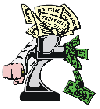INFORMATION ARTICLE

Let the Goose Live
By John D. Behle
(The
following is an excerpt from Mr. Behle's 5 day video
workshop manual)
For over 20 years I've been teaching mortgage investors not to kill the "Golden Goose." Selling and brokering notes is only the tip of the profit iceberg. The majority of profits can come from owning paper. It's easy to fund, you just need to know how. It's as simple to buy and own paper as it is to broker it. I've written many articles and books on the subject, but let's look at some more details.
In past articles I have shown many of 117 different ways to "improve" real estate paper. When I buy a note, I compare that note to my P.A.M. chart (Paper Analysis Matrix) that details different ways to improve paper for higher yields. I have found over 50% of the notes I buy will improve within the first 60 days. For a copy of the P.A.M. chart, Email Pat at pat@papergame.com and I'll send you a copy.
Many of the improvement techniques revolve around early payoffs (or "Re-funding") by the payor of the note. Suppose your buyer has a little cash or the ability to take out a smaller loan than is needed to pay you off totally. Today let's look at "Partial Payoff" techniques.
PARTIAL PAYOFF - SHORTER AMORTIZATION
We buy a $10,000 note and the payor has $2,500 he could pay. He may do it just for the incredible interest savings and shorter amortization. That immediately reduces the amount of our investment - The payor helps fund the purchase of his own note.
$10,000.00 note - pay $2,500 (($6,192.78 cost at 14%))
| Line | N | I | PMT | PV | FV |
| Line 1 | 360 | 8 | $73.38 | ($10,000.00) | - 0 - |
| Line 2 | 360 | 14 | $73.38 | ($6,192.78) | - 0 - |
| Line 3 | 172 | 8 | $73.38 | ($7,500.00) | - 0 - |
| Line 4 | 172 | 23 | $73.38 | ($3,692.78) | - 0 - |
Line 1 shows the original note.
Line 2 shows our cost at a 14% yield.
Line 3 shows the restructured note after a $2500 payment.
Line 4 shows our new yield of 23% (after the $2500 payment, our investment is $3,692.78)
The payor will save $11,295.44 in interest by paying the loan off over 15 years early!
We can even offer more of a benefit to the payor to pay make some extra principle payment. I call this one the "Buy one - get one Free." For ever $1,000 pre-paid, there will be a $1,000 additional reduction of principle. In other words, $1,000 now buys $2,000 equity.
PARTIAL PAYOFF - DISCOUNT
$1,000.00 example
| Line | N | I | PMT | PV | FV |
| Line 1 | 360 | 8 | $73.38 | ($10,000.00) | - 0 - |
| Line 2 | 360 | 14 | $73.38 | ($6,192.78) | - 0 - |
| Line 3 | 195 | 8 | $73.38 | ($8,000.00) | - 0 - |
| Line 4 | 195 | 15.6 | $73.38 | ($5,192.78) | - 0 - |
Line 1 shows the original note
Line 2 shows it's value when discounted to 14%
Line 3 shows the number of months left after the $2,000 reduction of principle
Line 4 shows the new yield after the $1,000 cash is received
Total pay. - original note - 360 x $73.38 = $26,416.80
Total pay. - new note - 195 x $73.38 = $14,309.10
Principle Pre-payment - = $ 1,000.00
Savings = $11,107.70
Our yield would only jump from 14% to 15.6% in the first example, but let's look at what $2,500 would do.
$2,500.00 example
| Line | N | I | PMT | PV | FV |
| Line 1 | 360 | 8 | $73.38 | ($10,000.00) | - 0 - |
| Line 2 | 360 | 14 | $73.38 | ($6,192.78) | - 0 - |
| Line 3 | 91 | 8 | $73.38 | ($5,000.00) | - 0 - |
| Line 4 | 91 | 17.5 | $73.38 | ($3,692.78) | - 0 - |
Our yield would jump to almost 18% and the payor would save $17,239.22 in interest!
These are just a few of the many techniques for improving notes. In future articles, I'll share some of our case histories with you. I needed to lay a foundation first. In the next article, I'll show you how we made $110,000 on a $75,000 bad note that only one other person in the country would even look at. Have a profitable day. See the article $100,000 Profit From A $75,000 "Bad Note
![]() To
Fax this article to someone else for free click on the
box.
To
Fax this article to someone else for free click on the
box.
Home
Free Articles